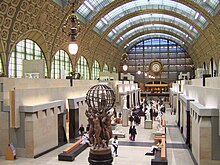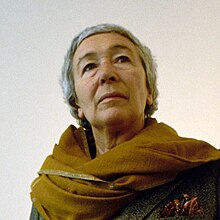Gae Aulenti
Gaetana "Gae" Aulenti (born December 4, 1927 in Palazzolo dello Stella , Province of Udine , Italy ; † October 31, 2012 in Milan ) was an Italian architect , interior designer, designer and architectural theorist. She became internationally known for the design of several famous museums in Paris and Barcelona .
Life
Gae Aulenti graduated from Politecnico di Milano with a degree in architecture in 1954 . She then worked as a freelance designer in Milan and designed furniture and interiors for Knoll International and Olivetti, as well as lights for Stilnovo and Artemide . 1955–1965 she was an editor and graphic designer at the magazine Casabella-continuità ( ISSN 0008-7181 ). 1960–1962 she taught architectural composition (approximately building science ) as a research assistant at the University of Venice . 1964–1967 she taught in the same position at the Politecnico in Milan.
She designed the award-winning Italian pavilion for the 13th Architecture Triennale in Milan in 1964. 1966–1969 she was Vice President of ADI, the Associazione per il Disegno Industriale (Society for Industrial Design). In 1974 she became a board member of Lotus International magazine ( ISSN 0076-101X ). 1976–1979 she taught at the Laboratorio di Progettazione Teatrale (theater project laboratory ) in Prato . In addition, she traveled to the USA , Canada , Spain , Germany , Sweden and Iran as a guest lecturer .

The extraordinarily versatile artist designed stage sets (especially for the director Luca Ronconi , who encouraged her to do this work), furniture and furnishings, gardens, residential buildings, hotels, schools and commercial buildings. She became internationally known in the 1980s. 1980–1986 she led the conversion of the Paris Gare d'Orsay into a museum. In 1987 the French President François Mitterrand made her Chevalier de la Légion d'Honneur (Knight of the Legion of Honor ) for this achievement . 1982–1985 she redesigned the Museum of Modern Art in the Center Georges Pompidou . In 1985 and 1986 she was involved in the renovation of Palazzo Grassi in Venice for museum purposes.
1985–1992 Gae Aulenti directed the conversion of the Palacio Nacional de Montjuic in Barcelona into the Museu Nacional d'Art de Catalunya . In 1989 she became an honorary member of the Association of German Architects BDA and in 1991 she received the Praemium Imperiale of the Japanese imperial family for her achievements in the field of architecture .
About her work and the lack of a consistent style in it, she remarked: “Because style is a mistake. I can't work with the same handwriting everywhere. Because it is the place that dictates the way something is to be designed. Style means the repetition of the same idea and the same details. I was never interested in that. " The Schöner Wohnen editorial team wrote about her: " Gae Aulenti's development is a creative emancipation story ; for the designer's right to individuality, free from dogmas and isms, she fights with wit and intellectuality. "
literature
- Charlotte Fiell; Peter Fiell (Ed.): Design of the 20th Century , Taschen Verlag, Cologne 2012, ISBN 978-3-8365-4107-7 ; P. 75.
- Sonia Ricon Baldessani: How women build. Architects. From Julia Morgan to Zaha Hadid. AvivA Verlag, Berlin, 2001, ISBN 3-932338-12-X ; Pp. 137-149
Web links
- Literature by and about Gae Aulenti in the catalog of the German National Library
- Official website
- Product overview and biography of Gae Aulenti on edition20
- Gae Aulenti. In: arch INFORM .
- Luigi Monzo: Gae Aulenti: Architect of Neoliberty (accessed November 1, 2012)
Individual evidence
- ↑ DerStandard.at of November 1, 2012
- ↑ Norman Kietzmann: Interview with Gae Aulenti at Designlines
- ↑ More beautiful living: The book of classics - The 500 best furniture and home accessories . Gruner + Jahr AG & Co KG, Hamburg 2011, ISBN 978-3-517-08706-1 , p. 190.
| personal data | |
|---|---|
| SURNAME | Aulenti, Gae |
| ALTERNATIVE NAMES | Aulenti, Gaetana |
| BRIEF DESCRIPTION | Italian architect |
| DATE OF BIRTH | 4th December 1927 |
| PLACE OF BIRTH | Palazzolo dello Stella , Udine Province, Italy |
| DATE OF DEATH | October 31, 2012 |
| Place of death | Milan , Italy |
